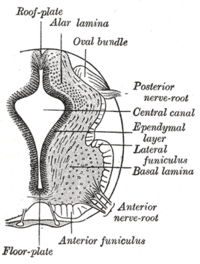
Photo from wikipedia
Significance An intriguing feature of the nervous system is its plasticity—the remarkable lifelong capacity to change and adapt in light of intrinsic and extrinsic stimuli. Among the many different adaptive… Click to show full abstract
Significance An intriguing feature of the nervous system is its plasticity—the remarkable lifelong capacity to change and adapt in light of intrinsic and extrinsic stimuli. Among the many different adaptive mechanisms that occur within the nervous system, changes in neurotransmission form an important plasticity-bestowing mechanism in the reconfiguration of neuronal circuits. Here, we reveal that physical activity and spinal cord injury can switch the neurotransmitter phenotype of the fast axial motoneurons to coexpress glutamate. Furthermore, our study shows that the adult vertebrate spinal motoneurons corelease glutamate alongside ACh in neuromuscular junctions to regulate motor behaviors. Thus, our findings suggest that fast motoneuron glutamatergic respecification enables a motor function-enhancing mechanism in vertebrates. A particularly essential determinant of a neuron’s functionality is its neurotransmitter phenotype. While the prevailing view is that neurotransmitter phenotypes are fixed and determined early during development, a growing body of evidence suggests that neurons retain the ability to switch between different neurotransmitters. However, such changes are considered unlikely in motoneurons due to their crucial functional role in animals’ behavior. Here we describe the expression and dynamics of glutamatergic neurotransmission in the adult zebrafish spinal motoneuron circuit assembly. We demonstrate that part of the fast motoneurons retain the ability to switch their neurotransmitter phenotype under physiological (exercise/training) and pathophysiological (spinal cord injury) conditions to corelease glutamate in the neuromuscular junctions to enhance animals’ motor output. Our findings suggest that motoneuron neurotransmitter switching is an important plasticity-bestowing mechanism in the reconfiguration of spinal circuits that control movements.
Journal Title: Proceedings of the National Academy of Sciences of the United States of America
Year Published: 2018
Link to full text (if available)
Share on Social Media: Sign Up to like & get
recommendations!